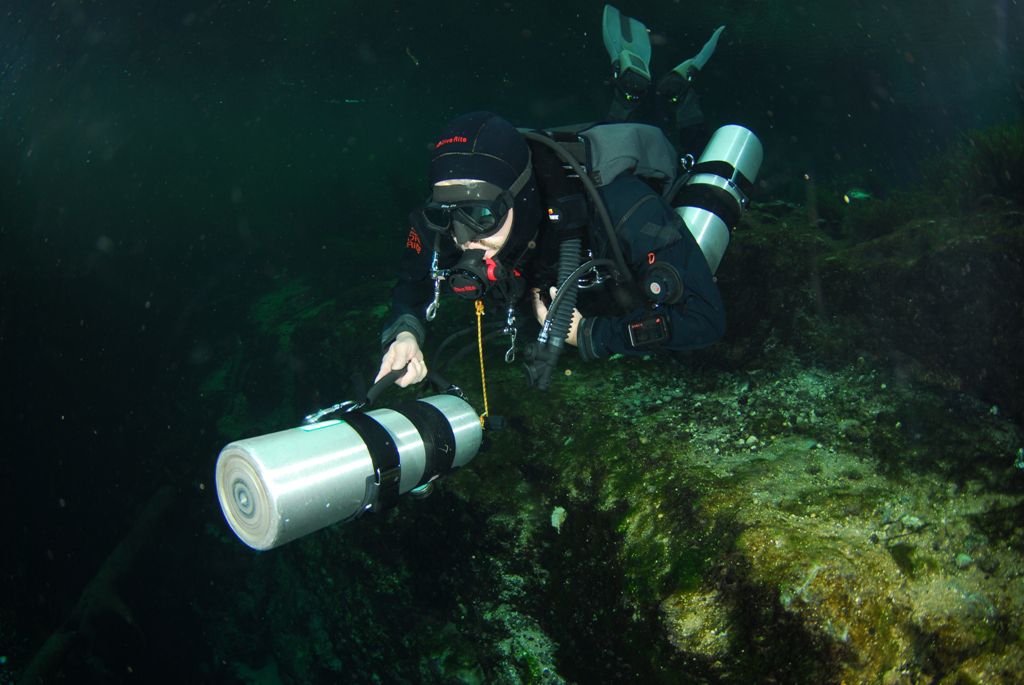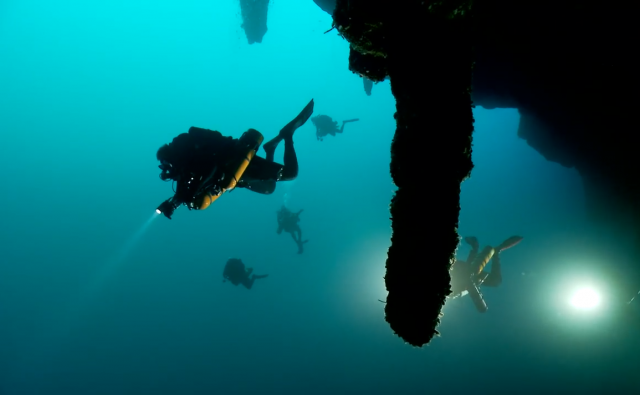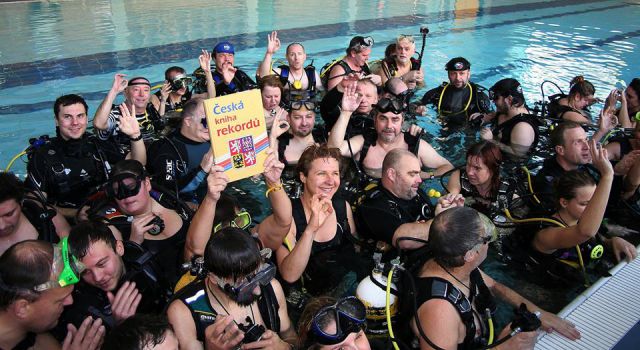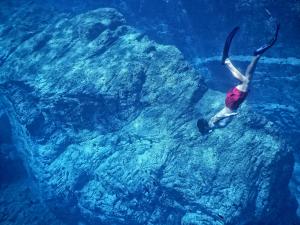Sidemount - History of the Diving Equipment Configuration

Photo : Pete Nawrocky (en.wikipedia.org)
Beginnings in the UK around 1960
The concept of sidemounting originated from cave diving in the UK, during the 1960s. The most frequent name mentioned together with the system was that of Mike Boone, British cave diver. The first time it was used, was during the speleological exploration of Hardrawkin Pot cave, Yorkshire, England Since 'dry' explorations were the base of these expeditions, divers occasionally encountered submerged passages that blocked further exploration. However, because they operated in very confined spaces, and most exploration remained primarily 'dry', they had to continue their dry passage afterwards leading to the next submerged passage.
Traditional configuration was inefficient or even dangerous in limited spaces. New approach to solve the problem knocked the door instantly. It led to extremely minimalist configurations, minimizing bulk, allowing squeezing through the tightest drowned restrictions and suitable wearing whilst going through the dry passages.
Many of these early sump explorers adopted an approach based upon a sturdy belt, with attached cam-band only. Old army oxygen masks were often included. This allowed a bottle to be dropped in and carried alongside the outer thigh. This allowed them to crawl, or wriggle, through the dry cave sections, whilst presenting a secure method of attachment for passing through submerged areas. Fins as a propulsion technique representatives join in the equipment after about 5 years of coming out of that system to ease up the wet way. Water in these passages was dark and murky due to the diver’s movements. Advanced propulsion techniques are useless there. Narrow profiles of the caves explored being a minimum larger than the diver’s profile made it useless to wear the BCD allowing the diver to avoid the contact with a cave walls. The Sidemount diving configuration development allowed in-depth exploration of the cave systems which were inapproachable or too dangerous for explorers using traditional back configuration (Wookey Hole, River Axe etc.). At the time, this approach to 'wet' cave exploration was generally called the 'English System'.
Florida 1970
The reasons for extension the approach over the ocean come from much darker side of diving. There was a fatal accident of an inexperienced and not-yet certified diver in Royal Springs on Florida in 1970. His body stayed fixed in an extreme narrow place and all the pick-up trials remained unsuccessful due to really reduced space. Even the most experienced divers in the area (Sheck Exley and Wes Skiles) entrusted with picking-up the body didn’t succeed with their traditional back configuration and the main problem was to get into the space. Further trials were stopped due to the extreme danger of the act. Sheck Exley decided to use minimalistic configuration of single bottle to one last trial to bring off the body and bring it to the surface. Wes Skiles played the back-up role and when he saw the practical usage of the atypical configuration in practice, he quickly recognized its potential and its possible application. He started the explorations of formerly and traditionally inaccessible spaces using that configuration and this lead to spreading up of the system all over the North America.
In 1977 belt configuration inspired by the English system of taking two independent bottles was implemented by cave diver Forrest Wilson. Bicycle bladders allowing upper mounting, better orientation and accessibility of bottles were incorporated by Wilson inspired by Woody Jasper soon afterwards. This lied down the base for so called bungee cords which are used in common Sidemount configurations pretty often. Major part of the explorations was undertaken in suffocated parts of the cave these days, and therefore need for buoyancy and trim control came into business again. Jasper and Wilson started to improve their equipment by adding up BCD into the configuration allowing sufficient buoyancy control and avoiding any contact with a cave walls and therefore rising up the sediments. They aimed to get the gas storage closer to the front of the diver’s body and to make them parallel to vertical and lateral body line, taking inspiration on Rory Dickins’ book “Physics and Diving Techniques”. Movement towards front of the bottles and additional BCD were the main conceptual differences of American and British approach.
US Army jacket Atpack used by Skiles improved the horizontal trim. Later on he tried to change it for commercial buoyancy jacket with similar results achieved. Skiles used this system during the exploration of Gator Cave in the Merrit’s Mill Pond. He succeeded to go through several narrows which were not passable during his previous trials neither by him nor by his colleagues wearing the traditional back configuration. When he was capable of lying down about 120 meters of rope in extremely narrow profile, he found the great potential of the configuration for explorations in such a pent place. This dive really opened the doors to massive use of Sidemount in cave diving in the USA.
A group of divers aroused using Sidemount configuration for formerly unapproachable spaces explorations worked on further improvement and development. Wes Skiles, Court Smith, Mark Long, Tom Morris, Woody Jasper and Lamar Hires – those were divers involved. This group became well known among the diving community especially for their successes in smaller and thinner caves and therefore the group got its nick “Mole Tribe”. Around 1985 Woody Jasper and Ron Simmons made a great progress in configuration development and succeeded in horizontal gas storage based on Ron Simmons’ proposal. This proposal contained of adapted mount, I-plate and integrated buoyancy compensator. This was the first system allowing successful commercial duplication.
Further Sidemount development
The first commercial configuration – Transpac were taken off by Dive Rite in 1995 on demands of Lamar Hires‘needs for expedition to Japan. Major part of divers used their own DIY configurations, despite the fact there was Transpac – the first commercial configuration available. Transpac turned into Nomad and Nomad EXP followingly and was adapted to other systems too, e.g. Armadillo Sidemount configuration introduced by Brett Hemphill (Golem Gear nowadays). Both two are number 1 and 2 commercial configurations used worldwide.
The year 2000 was crucial for the Sidemount development. The increasing interest in Sidemount was noticed by diving equipment producers. The mayor players started to develop their own systems. Mass use of Sidemount didn’t take its place till 2005-2010 but this concept gained its popularity together with worldwide rising popularity of advanced cave diving.
Steve Bogaerts introduced RAZOR – worldwide popular system based on the Hogartian approach and at the same time Hollis, UTD and OMS continued working on developing their own system. Steve Bogaerts was born in the Great Britain and well known as a cave diving pioneer. Coming out of his system on the European market was long awaited breakthrough. And it was followed by own training program teaching the specificities of using this system soon afterwards. System became really popular the moment PADI came out with Sidemount for recreational diving courses.
It is possible to say that Sidemount diving is one of the most dynamic areas of this sport. Divers recognized pretty quickly that it is on of the safest, most comfortable and most stabile way to enjoy the undersurface world and use of this configuration is not used for cave diving only. It found its way to commercial recreational space through wreck diving
Source:
- Heinerth J., Kakuk B. : Side Mount Profiles. Heinerth Productions Incorporated, 2010. ISBN-10: 0979878942
- en.wikipedia.org/wiki/Side_mount_diving: article „Side mount diving” from 3.6.2014
- scubatechphilippines.com/sidemount-diving-subic: article „Sidemount Diving Overview“
- www.diverite.com/blog








